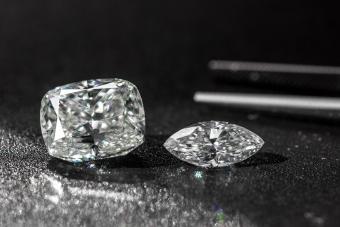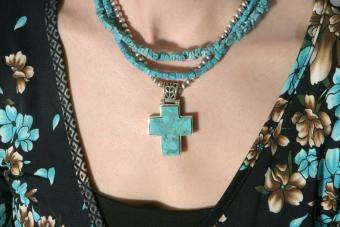
Is it a diamond or crystal moissanite? Sometimes even jewelers can't tell the difference, but are these gems truly equals?
What Is Crystal Moissanite?
Crystal Moissanite is a gem-quality jewel similar to a diamond. This naturally occurring mineral was first discovered by Dr. Henri Moissan in fragments from a meteor site in the Arizona desert. There wasn't enough of the mineral to be used for any practical application, but the natural particles had an incredible brilliance that appeared to even outshine diamonds.
Since that initial captivating encounter with the crystals over 100 years ago, scientists have tried to simulate natural moissanite, but didn't really achieve serious success until the 1990's.
Today's crystal moissanite jewelry is made from gems created by putting silicon carbide through a patented thermal crystal growing process. It's actually quite difficult to create, and this is probably why naturally occurring moissanite is so rare and minute. To date, only one company produces jewelry grade crystals: Charles and Colvard.
How Does It Compare to Diamonds?
Some jewelry industry insiders believe that manufactured moissanite actually surpasses the diamond on several levels, but others disagree. Let's compare a few key points.
Color
Diamonds come in a range of colors, although the purest "white" diamonds are judged the most valuable because they are also the most rare.
In addition to white, diamonds come in a rainbow of colors, including shades of:
- Yellow
- Pink
- Red
- Green
- Blue
- Brown
By comparison, moissanite nearly always seems to have a slight yellow tint that varies from one crystal to the next. This can make the crystals appear anywhere from mildly gray to nearly green.
Jewelers are able to counteract the natural color of the crystals and make them appear more diamond-like by displaying them under pink-tinged lighting. This is why the best way to discern the true color of one of these jewels is to view it in natural sunlight.
Brilliance
Diamonds have long been the standard for sparkling brilliance, in jewels and nearly anything else. However, manufactured moissanite does have slightly higher refractive qualities.
Moissanite has a peculiar quality known as "hexagonal polytipic". What this translates to in layman's terms is that the facets on the back of the crystal appear to double when viewed through the front, making it hard for your eyes to completely focus. This results in a marked difference in brilliance from diamonds that literally "dazzles" the eye.
Does this mean that moissanite is the better of the two gems? Again, industry insiders are divided in their opinions. Some actually do believe that moissanite is superior, while others feel the intense brilliance looks almost artificial. In the end, it seems to be a matter of personal preference.
Hardness
There's no doubt about it, the diamond is still the king of the Mohr hardness scale, rating a perfect 10, however, manufactured moissanite isn't far behind. The crystals rate a mere .75 of a point behind the ever-popular diamond.
What does this mean to jewelry lovers? Moissanite is nearly as durable as a diamond, and so less subject to casual damage when kept in a jewelry box with the rest of your collection.
Decide for Yourself
The following table shows a comparison of the most relevant qualities between diamonds, moissanite and the most common diamond simulant, cubic zirconia.
| Jewel | Mohr Hardness Rating | Brilliance | Fire | Luster | Average Price Per Carat |
| Diamond | 10 | 2.42 | .044 | 17.2% | $4500.00 |
| Crystal Moissanite | 9.25 | 2.65 | .104 | 20.4% | $525.00 |
| Cubic Zirconia | 8.25 | 2.17 | .060 | None | $75.00-$100.00 |
Depending on the qualities you're looking for, you can decide which of these jewels best fits your preferences and your wallet.
Telling the Difference
As alluded to at the beginning of this discussion, it's often difficult to tell diamonds apart from crystal moissanite. Although there are differences easily distinguished by the naked eye, jewelers rely on thermal probes to reveal "true" diamonds.
Interestingly, moissanite has thermal-conductive qualities that are amazingly similar to diamonds, and cause the gems to register as genuine diamonds although they really aren't. This can be quite confusing for experienced jewelers whose eyes are telling them one thing, but the probe is telling them another. It often takes a true professional to ferret out the truth.
A Personal Choice
Choosing between a genuine diamond and crystal moissanite is really a matter of personal preference. If you're not tied to the mystique of true diamonds, moissanite may be a reasonable alternative, especially if price is a major consideration.
On the other hand, nothing less than a genuine diamond will do for some people, and there is the advantage of being able to count on the resale value.
So, which is the gem for you?







